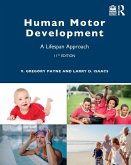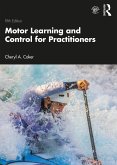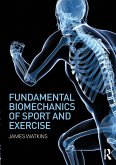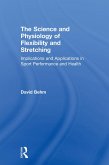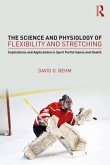- Broschiertes Buch
- Merkliste
- Auf die Merkliste
- Bewerten Bewerten
- Teilen
- Produkt teilen
- Produkterinnerung
- Produkterinnerung
Human Motor Development: A Lifespan Approach 10th Edition offers an overview to the study of changes in human movement across the lifespan. The book uses a wholistic approach and emphasizes the importance of intellectual, social and physical development and their impact on human motor development at all ages.
Andere Kunden interessierten sich auch für
![Human Motor Development Human Motor Development]() V. Gregory PayneHuman Motor Development104,99 €
V. Gregory PayneHuman Motor Development104,99 €![Fundamental Biomechanics of Sport and Exercise Fundamental Biomechanics of Sport and Exercise]() James WatkinsFundamental Biomechanics of Sport and Exercise241,99 €
James WatkinsFundamental Biomechanics of Sport and Exercise241,99 €![Motor Learning and Control for Practitioners Motor Learning and Control for Practitioners]() Cheryl Coker (USA Plymouth State University)Motor Learning and Control for Practitioners96,99 €
Cheryl Coker (USA Plymouth State University)Motor Learning and Control for Practitioners96,99 €![Fundamental Biomechanics of Sport and Exercise Fundamental Biomechanics of Sport and Exercise]() James WatkinsFundamental Biomechanics of Sport and Exercise69,99 €
James WatkinsFundamental Biomechanics of Sport and Exercise69,99 €![The Science and Physiology of Flexibility and Stretching The Science and Physiology of Flexibility and Stretching]() David BehmThe Science and Physiology of Flexibility and Stretching186,99 €
David BehmThe Science and Physiology of Flexibility and Stretching186,99 €![The Science and Physiology of Flexibility and Stretching The Science and Physiology of Flexibility and Stretching]() David BehmThe Science and Physiology of Flexibility and Stretching52,99 €
David BehmThe Science and Physiology of Flexibility and Stretching52,99 €![The Science and Physiology of Flexibility and Stretching The Science and Physiology of Flexibility and Stretching]() David BehmThe Science and Physiology of Flexibility and Stretching142,99 €
David BehmThe Science and Physiology of Flexibility and Stretching142,99 €-
-
-
Human Motor Development: A Lifespan Approach 10th Edition offers an overview to the study of changes in human movement across the lifespan. The book uses a wholistic approach and emphasizes the importance of intellectual, social and physical development and their impact on human motor development at all ages.
Produktdetails
- Produktdetails
- Verlag: Taylor & Francis Ltd
- 10 ed
- Seitenzahl: 556
- Erscheinungstermin: 4. Juni 2020
- Englisch
- Abmessung: 178mm x 253mm x 34mm
- Gewicht: 1142g
- ISBN-13: 9780367347376
- ISBN-10: 0367347377
- Artikelnr.: 59773210
- Herstellerkennzeichnung
- Libri GmbH
- Europaallee 1
- 36244 Bad Hersfeld
- gpsr@libri.de
- Verlag: Taylor & Francis Ltd
- 10 ed
- Seitenzahl: 556
- Erscheinungstermin: 4. Juni 2020
- Englisch
- Abmessung: 178mm x 253mm x 34mm
- Gewicht: 1142g
- ISBN-13: 9780367347376
- ISBN-10: 0367347377
- Artikelnr.: 59773210
- Herstellerkennzeichnung
- Libri GmbH
- Europaallee 1
- 36244 Bad Hersfeld
- gpsr@libri.de
V. Gregory Payne is a Professor Emeritus in the Department of Kinesiology at San Jose State University, USA. He formerly served as the Associate Dean for Research in the College of Applied Sciences and Arts and as Chair of the Department of Kinesiology. Payne is a specialist in human motor development with interests ranging from aging and physical activity to children's sports and fitness. He received a BS degree from Western Illinois University and later received that institution's Distinguished Alumni Award. He earned an MA from the University of Iowa and his PED from Indiana University. Payne worked for the Venezuelan Ministry of Education as a Peace Corps Volunteer in Venezuela following college. As a human motor development researcher and educator, Payne has produced over 170 publications, including numerous refereed articles and 19 editions of five books, and has made nearly 300 presentations throughout the world. He is an elected Fellow of the National Academy of Kinesiology and was a member of the task force that developed the NASPE National Physical Education Standards. The many honors and awards Payne has received include being selected International Professor of the Year at SJSU, receiving the Distinguished Service Award from the California Governor's Council on Physical Fitness and Sports and the prestigious Research Quarterly for Exercise and Sport Research Writing Award for research involving children's physical activity and cardiovascular endurance. He has held offices in several organizations including President of NASPE and Chair of the Motor Development Academy. He is an elected Fellow of the National Academy of Kinesiology and the Research Consortium of AAHPERD (SHAPE America), has chaired two editorial boards, and has reviewed for many journals. Larry D. Isaacs is Professor Emeritus and former Director of the Exercise Physiology Program, Department of Biological Sciences, College of Science and Mathematics at Wright State University, USA. Isaacs received both his BS and MS degrees from Virginia Commonwealth University, where he specialized in human motor development and also developed a strong interest in both human physiology and exercise physiology. Following four years of public school teaching, Isaacs attended the University of Maryland and received his doctorate in 1979. He continues to serve as a reviewer for many scholarly journals. In addition, he has published numerous scholarly articles and has authored, coauthored, and contributed to 21 textbooks. He is certified with the American College of Sports Medicine (Certified Exercise Physiologist) and was awarded Research Fellow status by AAHPERD/SHAPE. In addition, he has received the Wright State University Presidential Recognition award for research. Isaacs continues to work part-time as a clinical exercise physiologist at Hilton Head Hospital, Hilton Head Island, South Carolina, where he works with both cardiac and pulmonary patients.
Part I
1. Introduction to Motor Development
2. Cognitive and Motor Development
3. Social and Motor Development
Part II
4. Prenatal Development Factors
5. Effects of Early Stimulation and Deprivation
Part III
6. Growth and Maturation
7. Physiological Changes: Health-Related Physical Fitness
8. Movement and the Changing Senses
Part IV
9. Infant Reflexes and Stereotypies
10. Voluntary Movements of Infancy
11. Fine Motor Development
12. Fundamental Locomotion Skills of Childhood
13. Fundamental Object-Control Skills of Childhood
14. Youth Sports
15. Movement in Adulthood
Part V
16. Assessment
1. Introduction to Motor Development
2. Cognitive and Motor Development
3. Social and Motor Development
Part II
4. Prenatal Development Factors
5. Effects of Early Stimulation and Deprivation
Part III
6. Growth and Maturation
7. Physiological Changes: Health-Related Physical Fitness
8. Movement and the Changing Senses
Part IV
9. Infant Reflexes and Stereotypies
10. Voluntary Movements of Infancy
11. Fine Motor Development
12. Fundamental Locomotion Skills of Childhood
13. Fundamental Object-Control Skills of Childhood
14. Youth Sports
15. Movement in Adulthood
Part V
16. Assessment
Part I
1. Introduction to Motor Development
2. Cognitive and Motor Development
3. Social and Motor Development
Part II
4. Prenatal Development Factors
5. Effects of Early Stimulation and Deprivation
Part III
6. Growth and Maturation
7. Physiological Changes: Health-Related Physical Fitness
8. Movement and the Changing Senses
Part IV
9. Infant Reflexes and Stereotypies
10. Voluntary Movements of Infancy
11. Fine Motor Development
12. Fundamental Locomotion Skills of Childhood
13. Fundamental Object-Control Skills of Childhood
14. Youth Sports
15. Movement in Adulthood
Part V
16. Assessment
1. Introduction to Motor Development
2. Cognitive and Motor Development
3. Social and Motor Development
Part II
4. Prenatal Development Factors
5. Effects of Early Stimulation and Deprivation
Part III
6. Growth and Maturation
7. Physiological Changes: Health-Related Physical Fitness
8. Movement and the Changing Senses
Part IV
9. Infant Reflexes and Stereotypies
10. Voluntary Movements of Infancy
11. Fine Motor Development
12. Fundamental Locomotion Skills of Childhood
13. Fundamental Object-Control Skills of Childhood
14. Youth Sports
15. Movement in Adulthood
Part V
16. Assessment


